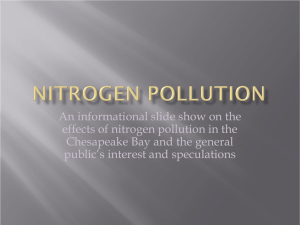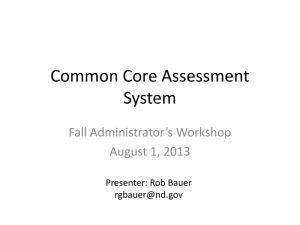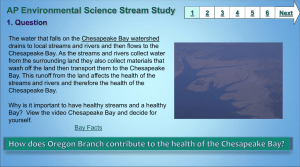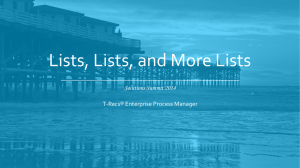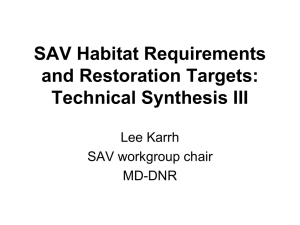PowerPoint - Severn River Association
advertisement
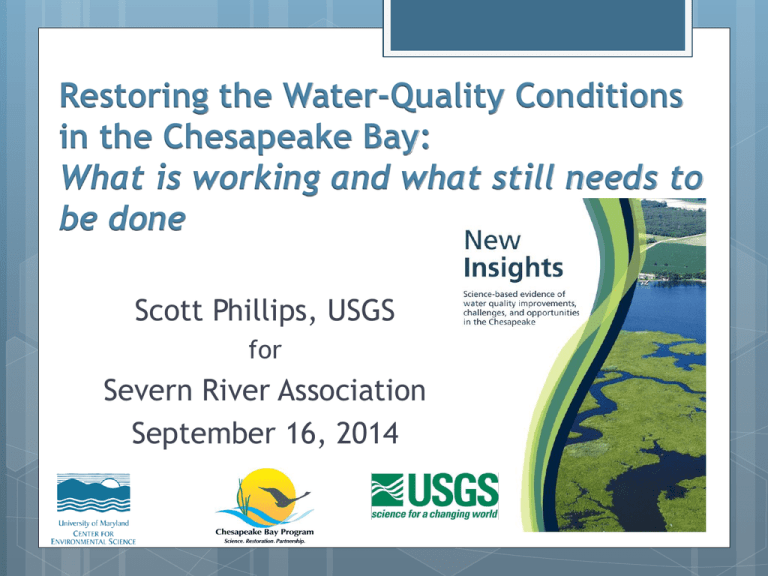
Restoring the Water-Quality Conditions in the Chesapeake Bay: What is working and what still needs to be done Scott Phillips, USGS for Severn River Association September 16, 2014 Many Contributors Authors: Christina M. Lyerly, Ana L. Hernández Cordero, Katherine L. Foreman and William C. Dennison (University of Maryland Center for Environmental Science) and Scott Phillips (USGS) Synthesis Team: Thomas E. Jordan (Smithsonian Environmental Research Center), Walter R. Boynton and Caroline Wicks (University of Maryland Center for Environmental Science), Kenneth W. Staver (University of Maryland Wye Research and Education Center), Gary Shenk (U.S. Environmental Protection Agency), Kenneth E. Hyer, Laura Medalie, and Peter Tango (U.S. Geological Survey), and Carlton Hershner (Virginia Institute of Marine Sciences) Science Communication, Design, & Layout: Brianne Walshe (University of Maryland Center for Environmental Science) Outline •Chesapeake Bay Issues •Improving water quality • What works • Challenges • What we need •Wrap-up and Questions U.S. Department of the Interior U.S. Geological Survey Chesapeake is a Degraded Ecosystem Decline of fish and wildlife Populations Health Over harvesting Poor water quality DO, clarity, contaminants Loss of habitat Invasive species Caused by: Population growth and land change Climate variability Bay Watershed Bay WatershedTrends Population Trends (1950 2030) Population (1950 – -2030) Data provided by State and Local agencies Population Population 20,000,000 15,000,000 10,000,000 5,000,000 0 1950 1950 1960 1970 1980 1990 2000 Year 2010 2020 2030 2040 2030 Climate variability River Flow 1. 2. 3. Delivers nutrient, sediment, and contaminants Salinity and temperature Highest in spring 4. 5. Low DO and clarity Varies each year May be more extreme in the future Restoration:Chesapeake Bay Program Federal Chesapeake Chesapeake Executive Executive Council Council Citizens’ Citizens’ Advisory Advisory Committee Committee Independent Independent Evaluator Evaluator Principals’ Principals’ Staff Staff Committee Committee Local Local Government Government Advisory Advisory Committee Committee Scientific Scientific & & Technical Technical Advisory Advisory Committee Committee Management Management Board Board Action Action Teams Teams Goal Implementation Teams Protect Protect & & Restore Restore Fisheries Fisheries Implementation Implementation Workgroups Workgroups (TBD) (TBD) Protect Protect & & Restore Restore Vital Vital Aquatic Aquatic Habitats Habitats Implementation Implementation Workgroups Workgroups (TBD) (TBD) Protect Protect & & Restore Restore Water Water Quality Quality Implementation Implementation Workgroups Workgroups (TBD) (TBD) Maintain Maintain Healthy Healthy Watersheds Watersheds Implementation Implementation Workgroups Workgroups (TBD) (TBD) Foster Foster Chesapeake Chesapeake Stewardship Stewardship Implementation Implementation Workgroups Workgroups (TBD) (TBD) Enhance Enhance Partnering, Partnering, Leadership Leadership & & Management Management Implementation Implementation Workgroups Workgroups (TBD) (TBD) Technical Technical Support Support & & Services Services -- Assessment Assessment -- Monitoring Monitoring && Modeling Modeling -- Communications Communications EPA DOI: USFWS, NPS, USGS USDA NOAA DOD Six States Bay Commission Local governments and communities Academic Chesapeake 2000 Executive Order New Bay Agreement Improving water quality Fish kills Underwater grasses (SAV) CBP: • Improve DO and clarity for fisheries and SAV • Reduce nutrients and sediment (TMDL) • Practices in place by 2025 • Two-year milestones Measuring Progress Track practices Water quality in the watershed Improvements in DO clarity, and SAV Monitoring programs Summarize what works and ways to improve Add map of monitoring Lessons from Chesapeake Bay Restoration Efforts Review of over 40 case studies Lessons under three broad categories: 1. 2. 3. What Works Challenges What We Need What Did We Learn? What you will hear 1. What Works 2. Challenges 3. WWTP Air emissions Some agricultural practices “Response times” Population Growth What We Need Location, location, location should guide restoration efforts Innovative practices Monitoring What Works Lesson 1: Wastewater treatment Upgrades in both nitrogen and phosphorus wastewater treatment result in rapid local water-quality improvements Lesson 1: WWTP -Reduced nitrogen loads to the Upper Patuxent River -Resurgence of submerged aquatic vegetation Changes in TN loads (1984–2004) Changes in submerged aquatic vegetation (SAV) (1978–2008) Data from Boynton et al., 2008 Data from Testa et al., 2008 WWTP Upgrades: Improvements and challenges Potomac River Blue Plains (DC) Fairfax County Mattawomen Creek Challenges: Increasing population Costs Only 20% of nutrient load What Works Lesson 2: Reducing N in rainfall Sources: power plants, vehicles, and manure Power plant controls lead to reductions in atmospheric nitrogen deposition Annual mean wet inorganic nitrogen deposition US EPA Clean Air Markets: 2009 Results Lesson 2: Air Power plant reductions are directly linked to improved surface-water quality in mostly-forested areas Changes in nitrate-N concentrations at 3 water quality monitoring stations (1986–2009) Data from Eshleman et al., 2013 Air: Vehicles and animals Cars and trucks 58% of nitrogen in air Emission controls More miles driven Manure Ammonia Local effects What Works Lesson 3: Agricultural practices Reductions of agricultural nutrient sources result in improved local stream quality Cover crops Livestock exclusion Manure management Photo © top left: Nicholas Tonelli, Flickr; top right: Jeff Vanuga, USDA NRCS; bottom: USDA. Lesson 3: agriculture Cover crops improved water quality Changes in groundwater nitrate-N concentrations in 2 agricultural fields (1986–1998) Wye River area, Eastern Shore MD Data from Staver and Brinsfield, 1995 & 2000 Agricultural practices Manure and fertilizer N and P changes Stream bank fencing Lower nutrients, sediment and bacteria Stream conditions What Did We Learn? What you will hear 1. What Works 2. Challenges 3. WWTP Air emissions Some agricultural practices Response times Population Growth What We Need Location, location, location should guide restoration efforts Innovative practices Monitoring Challenges Lesson 4: Response times Many practices provide initial water quality improvements in runoff; Full benefits to stream conditions can be delayed -Times vary from a few years to over 100 years -Average is 20 to 30 years Sanford et al., 2012 Challenges Lesson 5: Population growth Improvements in water quality can be counteracted by changes in nutrient sources and land-use practices Future Development Lesson 5: Growth Intensified agriculture has counteracted reductions in wastewater treatment plant nutrient loads in the Choptank River Increases in TN and TP at Greensboro water quality monitoring station (1968–2012) Increases in wheat and corn yields in the 5 counties within which the Choptank River basin is located (1926–2011) Data from the USDA National Agricultural Statistics Service Data from Fisher, 2006 What Did We Learn? What you will hear 1. What Works 2. Challenges 3. WWTP Air emissions Some agricultural practices “Lag times” Population Growth What We Need Location, location, location should guide restoration efforts Innovative practices Monitoring What We Need Lesson 6: Type and location of restoration Observable water quality responses are more likely to occur if A) location specific sources of pollution are identified and B) targeted practices are implemented. Lesson 6 Corsica River: -WWTP -Ag practices -Water-quality improvements Changes in TN and TP concentrations in Three Bridges Branch and Gravel Run (2006–2011) Data from Batchelor et al., 2011 What We Need Lesson 7: Innovation and stormwater An array of practices to promote stormwater infiltration and retention are needed in urban and suburban areas Rain gardens Pervious surfaces Lesson 7 Lesson 7: Other approaches Constructed wetlands Stream restoration Monitoring needed What Did We Learn? Summary 1. What Works 2. Challenges 3. WWTP Air emissions Some agricultural practices Response times Population Growth What We Need Types and location of restoration efforts Innovative practices Monitoring What you can do We need you! 1. Your home 2. Our kids 3. Education Community efforts 4. Fertilize less Capture runoff Clean ups Watershed organizations Political leaders Be informed Tell them what you think Thank you and questions Report at ian.umces.edu http://chesapeake.usgs.gov U.S. Department of the Interior U.S. Geological Survey SRA’s Meet The Candidates Night Who? Steve Schuh and George Johnson Candidates for County Executive • When ? Friday Oct 17th @ 7:00PM • Wood Memorial Presbyterian Church See you there


